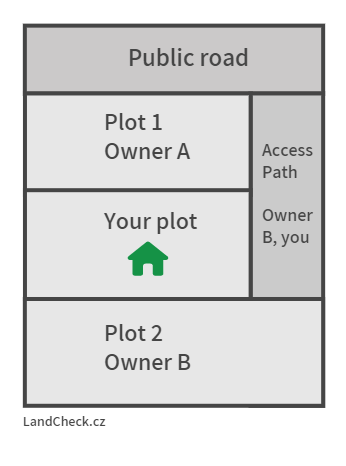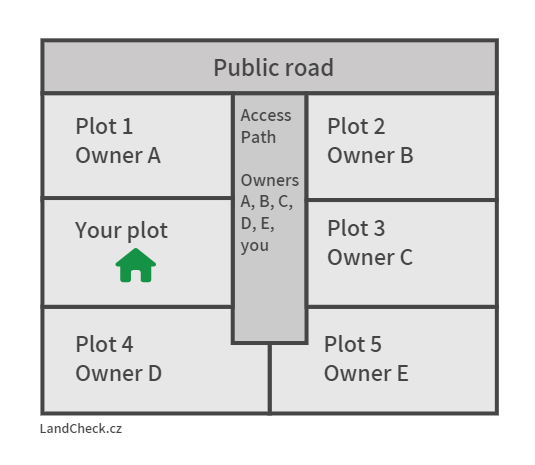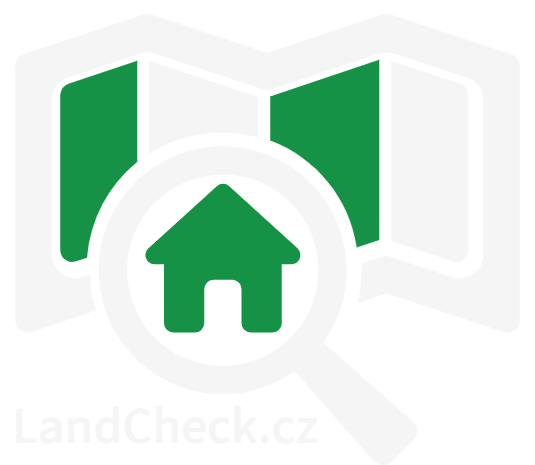You cannot build a house in the middle of steep rock (regardless of the apeal it might have) without a path to get there. That is just common sense. But having a legitimate access path to your plot requires more than that and it is essential to get building permit.
You need to have an absolute right (applicable with regards to every person) to access your land. Legal requirement for every family house land plot is to be accessible by vehicle (a thing that you want anyway). As per Section 20 (7) of the Decree 501/2006 Coll., on general requirement on land use, each family house needs to have an access road 2.5m wide ending max 50m from the house. To be able to secure such a road, you have two main options – have an immediate border to a plot with public road on it or have a right to a land that has immediate border to such a plot.
Immediate border to a public road
When we talk about a plot with public road, we mean a plot on which a public road is built. The requirement of public road is there because you need to have right to use it. Such road is usually owned by a municipality (or municipality division in bigger cities), a regional administration (Kraj) or the state (Czech Republic). It might be a private road but you must have right to use it. Public administrative bodies cannot exclude you from the usage of the road but there might be special conditions that apply to situations when you want to connect to the public and private road. We outline some them below in this article. You can find information about the plot ownership and the road in land register. We provide instructions how to use land register in this article.
Right to a land with immediate border
You do not have to be a sole owner or an owner of the access path at all to be able to build a house on your land. However, you need to have some kind of right to the access path or the land with the access path. There are three options how to secure a right of access thru a land that is not yours only – joint ownership, easement or contract.
Joint ownership means that you and other people are owners of one land. This land provides access to the lands of the owners. This situation typically arise in older establishments (Situation A) or in development projects (Situation B).


Both situations have naturally their risky aspects. For Situation A, the main risk is you need to agree with the other owners on everything, including investments, which may cause major clashes, as neighbors generally have different opinions on what is necessary, suitable or useless. Also, it is your responsibility to maintain the path, which may incur additional costs (as hinted above). In the schema above, you would have to deal with Owner B while Owner A is safe as he/she has a direct access to the public road.
Situation B has more variables to consider: Developers usually buy one huge land that they later divide into several plots. In order to secure access for all of the plots, the developer saves a lane in the middle and builds or claims to build a road on it. This access road remains owned by the developer until final building approval. After the approval, the developer is done with the area and transfers the ownership of the access road to either the municipality (so it becomes public road) or to the land owners (as shown in the schema above). For the land owners, it is usually better if the municipality takes over the access road because then, it also invests in it and the maintanance costs do not lie on the land owners. If the municipality does not consent to the transfer, the access road is transferred to the land owners and the scenario is similar to the one in Situation A.
Usually in the moment when you have a chance to buy one of the plots in the development area, the development project is in the beginning or better, in the middle of the works. The developer then promises what works will be done on the access road and what happens with it once finished (transfer to the municipality or to the land owners). By this time, the developer should have already negotiated with the municipality to know their stance.
The problem is that the developers might be unreliable or get into troubles during the development so the works might take longer or might never be completed. In such cases, you cannot usually get building permit. What can you do if the works are well past due data? Sue the developer? That takes long and the company might dissolve by the time the proceedings start. Build the access road yourself? You do not own the land and you already paid for the construction (in the land price that is higher than if no access road was being built) and you would have to deal with the other land owners. Find alternative access path? Might be difficult, lengthy or even impossible as you need to find the alternative and agree with the land owners.
You can of course mitigate the risk of unreliable developer in several ways, please contact us to find out how.
Watch out for hidden lanes along the road
To conclude, we just want to show you a land that is discreetly isolated from the public road. Even though in our schematic plan, it seems clear, it may be quite hidden in the land register map – you just see another lane next to the road that may actually seem to overlap with the road. The lane is owned by another person who might not be willing to grant you the access.

What roads you can connect to
Or rather cannot – you cannot directly connect to road for motor vehicles. For the rest of the roads, we point out that the authorities evaluate the security situation of the connection. Road owner’s consent to connection used to be required for all road types except for road type “purpose-built”, nowadays the authorities ask only for the owner’s opinion. Mayor of municipality in which area the road is shall have a so called road passport with road types.
How to connect to access road
Requirements on the connection of the access road (from spacial planning and land purchase point of view) are
- sufficient range of vision;
- suitable distance of connection;
- minimum width 3.5m and height 4.1m in case the access road is inclosed by fence (relevant for the Situation A and B above, requirement for fire brigade arrival);
- for access road longer than 50m, there should be a turning place in the end (relevant for the Situation A and B above, requirement for fire brigade arrival).
Also, note that source of water needs to be available (either in specialized public pipes with under- or overground hydrant or a fire pond). If you are unsure that these parameters are fulfilled, we recommend to consult an architect or transportation authority. We are also able to provide assistance in both options.
